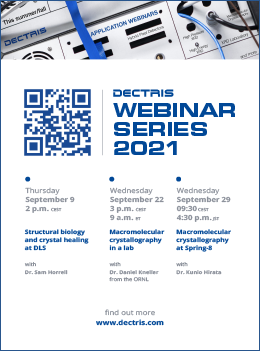


Feature article
Museum crystallography and community interactions
![Celestianthumbnail [Celestianthumbnail]](https://www.iucr.org/__data/assets/image/0003/151770/Celestianthumbnail.jpg)
Benitoite, California’s state gemstone. This benitoite ‘wreath’ is one of NHMLA's more famous specimens. Photo credit: NHMLA.
Museums are not just warehouses of objects. While the Natural History Museum of Los Angeles County (NHMLA) does have many objects (>35 million and counting) in its collections, and the gems, minerals, rocks and meteorite collections specifically at NHMLA house about 175,000 specimens, our larger goal is to serve our communities, both the scientific and broader public. The museum is a repository for extinct materials (e.g. from depleted mines, excavated land to make way for buildings, changed environs) and newly discovered crystals, either by natural processes or synthesized in the lab. The museum is a trusted resource, where new knowledge can be generated and interacted with, in an accessible and safe space.
One theme of research in the mineral sciences department at NHMLA involves interactions between humans and the minerals in the environment. This can be thought of in three ways: (1) human influence on the landscape that alters solid Earth chemistry in a permanent way, (2) anthropogenic changes to the Earth system that affect climate and biological processes, and (3) mineralogical and industrial processes that directly affect human health.
One way to measure how fast a planet is changing is to measure its mineral diversity over time. Today, there are over 5700 minerals (mindat.org) that have been described with about 100 new minerals each year, but the Earth started with roughly 250 minerals (Hazen et al., 2008). As the Earth changed (e.g. plate tectonics, the Great Oxidation Event, biomineralization), the chemistry of Earth also evolved. These major events are marked by changes in mineral diversity in the rock record. Human-environment interactions have produced over 200 minerals that would not have otherwise occurred (Hazen et al., 2017), and many of these are now curated in NHMLA’s permanent collections. Two examples of these minerals are rowleyite (Kampf et al., 2017) (Fig. 1) and phoxite (Kampf et al., 2019), which are new structures recently discovered from the Rowley Mine. This mine allowed bats to take residence, and chemicals in the bat feces reacted with the mine wall to produce rowleyite (the most porous framework mineral) and phoxite (a porous phosphate oxalate framework structure). Work at NHMLA uses in situ diffraction to monitor crystal growth so that we can better understand the biogeochemical conditions of formation and the mechanisms of crystallization. Both new minerals have potential applications in carbon capture and agriculture, respectively, which would further increase the footprint of human-environment influence. The rapid expansion of the mineral kingdom that is co-evolving with human activity is one global marker of changes to Earth chemistry. It thus is thought of as an indicator of the start of the proposed Anthropocene Epoch.
![[CelestianFig1]](https://www.iucr.org/__data/assets/image/0004/151771/CelestianFig1.png)
In today’s oceans, marine pH changes resulting from carbon dioxide emissions to the atmosphere affect the balance of minerals present. NHMLA collaborates with the University of Southern California and CalTech to determine carbonate and sulfate minerals (e.g. calcite, aragonite, barite) present in the marine water column and compares that with the seafloor sediment record (Dong et al., 2019). Not only are naturally occurring materials preserved in the geologic record, but new anthropogenic materials are incorporated as inclusions within crystals that will be preserved for geologic time. NHMLA has found the structurally disordered Magnelí phases (Fig. 2, sub-stoichiometric titanium oxides, TixO2x-1 for x = 4 to 10) that form at coal-burning power plants (Yang et al., 2017) in a wide range of environments, from the bottom of the ocean to the tops of Everest (collaboration with American Alpine Climbing Association) to evaporite minerals in hypersaline lakes (Celestian et al., 2021). The biological effects of Magnelí phases are an area of ongoing study, but they are structurally stable, globally distributed and may have served as a trace mineral for the onset of the Industrial Revolution.
![[CelestianFig2]](https://www.iucr.org/__data/assets/image/0005/151772/CelestianFig2.png)
Ongoing and pervasive extraction and application of heavy metals have impacted human health. There are hundreds of examples of humans being affected by heavy-metal poisoning events. One example close to NHMLA is the environmental disaster of South Los Angeles at the former Exide lead-acid battery recycling facility (Johnston & Hricko, 2017). Funded in part by the Getty Foundation’s Pacific Standard Time 2024 (Vankin, 2021), Self-Help Graphics and NHMLA are developing a process to sequester Pb. This work will involve designing new crystals and modifying naturally occurring microporous minerals to selectively absorb Pb from soils in community gardens and yards where Pb levels can exceed 500 ppm. This project will not replace the responsibilities of government clean-up efforts but should provide a means for community members to feel safer in their own homes and gardens. The success of the project will depend on community trust garnered through effective educational initiatives regarding crystallography and crystal chemistry to demonstrate material effectiveness and stability. The resulting Pacific Standard Time 2024 art exhibition will deploy a temporary remediation method along with scientific communication through art.
Museums utilize crystallography for both basic research and applied initiatives to expand knowledge of minerals and their structural dynamics. As a publicly supported non-profit institution, NHMLA’s mission is to serve our community. Crystallography allows us to learn more about how humans influence and are impacted by minerals and enables advancement of that mission.
References
Hazen, R. M., Grew, E. S., Origlieri, M. J. & Downs, R. T. (2017). Am. Mineral. 102, 595–611.
Johnston, J. E. & Hricko, A. (2017). Environmental Justice, 10, 162–167.
Kampf, A. R., Celestian, A. J., Nash, B. P. & Marty, J. (2019). Am. Mineral. 104, 973–979.
Vankin, D. (2021). Los Angeles Times, January 27.
Dr Celestian is Associate Curator of Mineral Sciences at NHMLA.
Copyright © - All Rights Reserved - International Union of Crystallography







